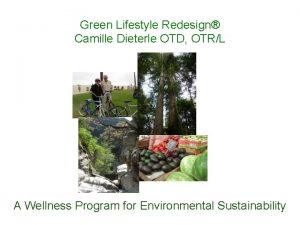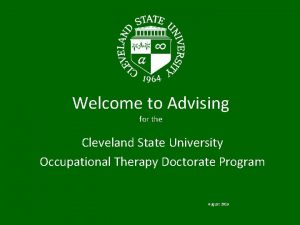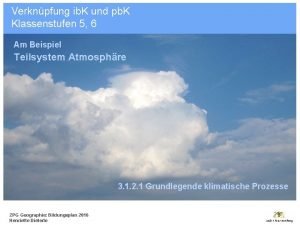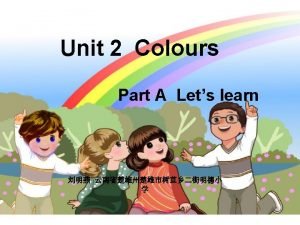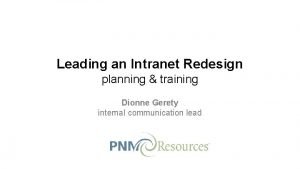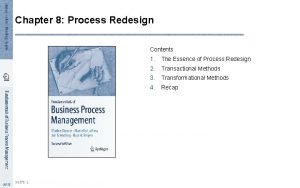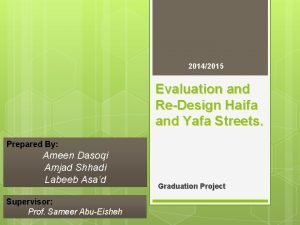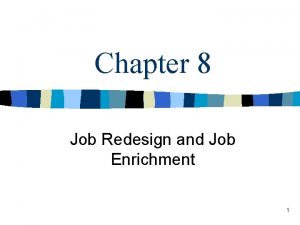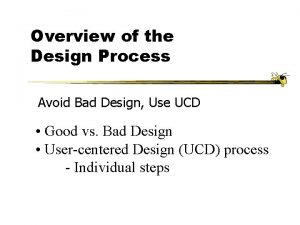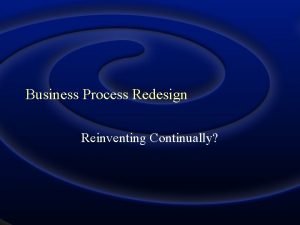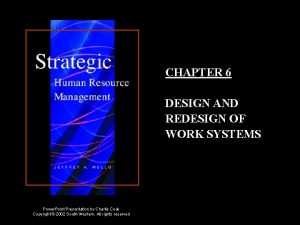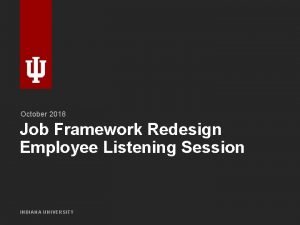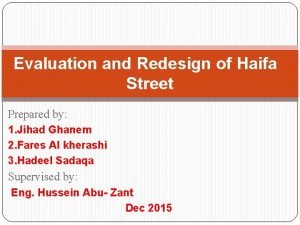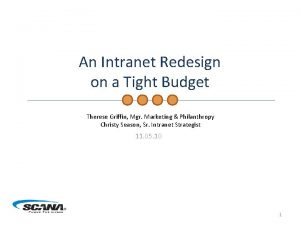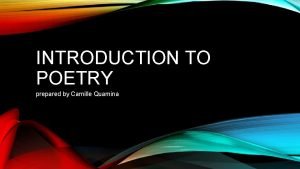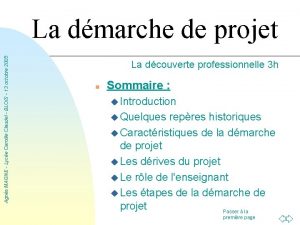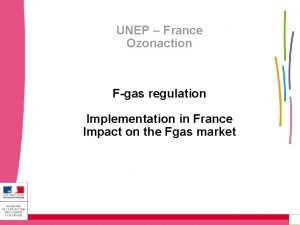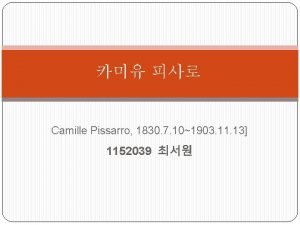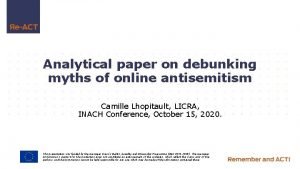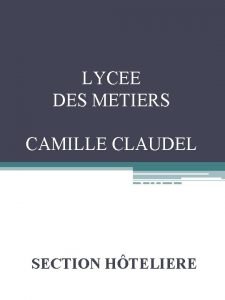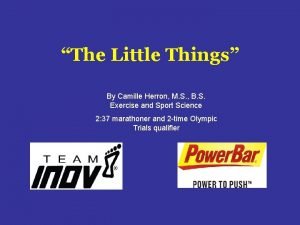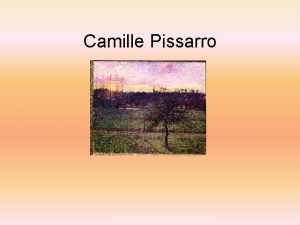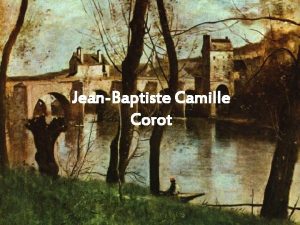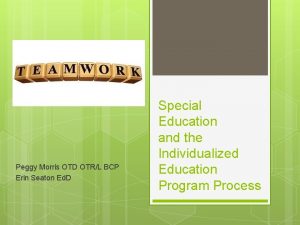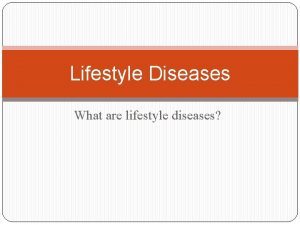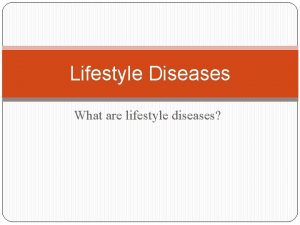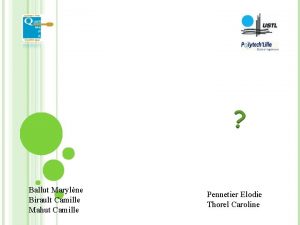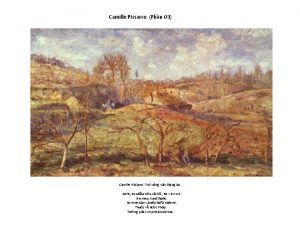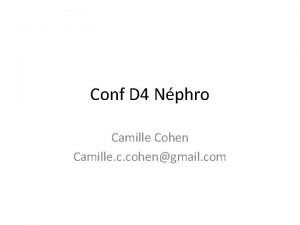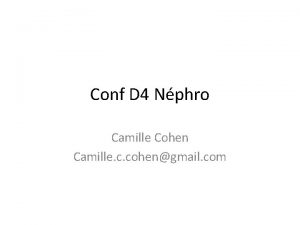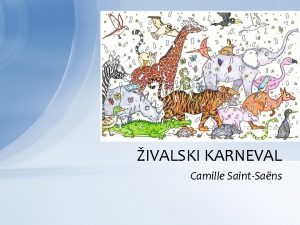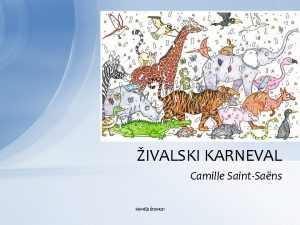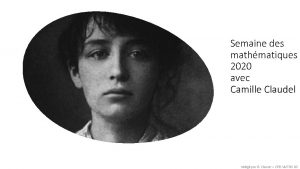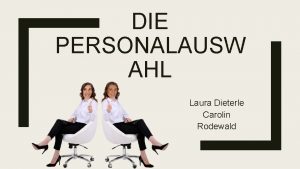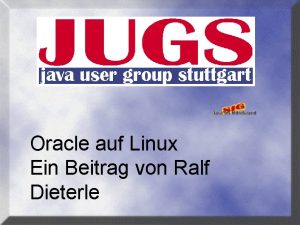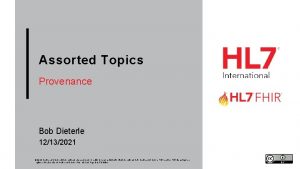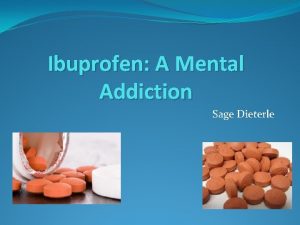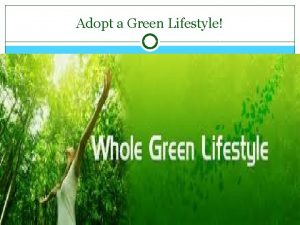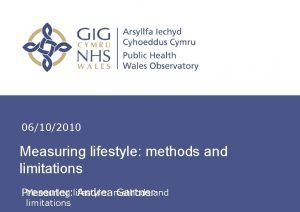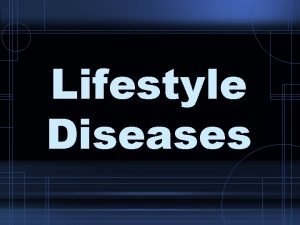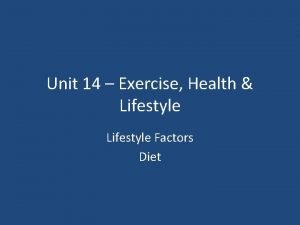Green Lifestyle Redesign Camille Dieterle OTD OTRL A
































- Slides: 32

Green Lifestyle Redesign® Camille Dieterle OTD, OTR/L A Wellness Program for Environmental Sustainability

Societal Problem -Consensus • 2005 -2015 United Nations Decade of Education for Sustainable Development • 2006 An Inconvenient Truth • 2007 "Warming of the climate system is unequivocal, " -California Senate's Environment

2007: The Green Movement goes Mainstream • July 2007 Time special edition on Global Warming • May 2007 Vanity Fair Green issue • Newsweek, US News & World Report, NPR & National Geographic Climate Connections Series, all the major newspapers

Solution • Large scale changes as soon as possible: – Extraction – Harvesting – Manufacturing – Distribution – Consumption

Solution • Consumer demand drives markets, shapes trends, and dictates culturally acceptable behaviors and practices. • Consumers need to change the way they are using natural resources.

“What we need is a new ethic in which every person changes, lifestyle, attitude, and behavior. ” Achim Steiner, United Nations Environment Program, 2007

We all need to change our lifestyles. David Miliband, Environment Secretary, UK, 2007

Common Barriers • • • Time Inconvenience Expense Complexity & confusion Feeling like one person can’t make a difference • Feeling overwhelmed with so much information & enormity of problem • Apathy

Methods - Occupational Science • Education • Habit Change • Overcoming Barriers (self-efficacy & selfesteem) • Identity • Transcendence • Physical & mental health & well being • Tempo

Ecological Occupations: • Taking care of nature • Being in nature

Purpose and Objectives • To increase participation in ecological occupations – Participants will gain experience • being in nature • taking care of nature

Goals and Measurements • to increase knowledge of sustainable living and how connection to nature can increase health and well being • to increase participation in ecological occupations New Ecological Paradigm Scale (NEP) Pre & post test SF-36 health & well being scale • to increase subjective well being

Population • USC campus community – Students – Faculty – Staff

Format • Faculty & Staff – 8 week modular format • Students – One-time workshops – Sports & Rec Center – Student Clubs – Earth Week

Modules • • • Intro & Managing Waste Nurturing through Food Transportation & Time Use Incorporating Nature Connecting with Chemicals • Saving Energy (& money) • Conserving Water • Cultivating Happiness & Tying It All Together

• • • Conservation psychology Environmental health Education Sociology

Incorporating Nature • Decreases Sx of depression, anxiety, & ADD (Townsend & Ebden, 2006) (Faber Taylor et al. 2001, Kuo & Faber Tabor, 2004) • Green exercise decreases blood pressure & elevates mood more than gym exercise (Pretty, Hines, & Peacock, 2006) (Bodin & Hartig, 2003) • Speeds recovery time after surgery (Ulrich, 1984) • Better pain control during medical procedures (Diette et al. , 2003) • Workers with windows report less stress, frustration & illnesses, & more patience (Pretty, Hine & Peacock, 2006) • Biophilia hypothesis: “the innately emotional affiliation of human beings to other organisms. ” -E. O. Wilson

Results

Results

Results

Results - Green Behaviors • “I became more aware of my shopping and consumption. I waste a lot less now!” • I’m shopping for locally grown and produced food and items. I walk or bike instead of driving when feasible. • I’m more conscious of harmful chemicals in the products I use and avoiding them. • I’m recommitted to vegetarianism. • I’m using a reusable water bottle. I learned the uselessness of plastic water bottles.

Results - Health Benefits • “Clarity of mind, refreshing, socializing, more calm, less stressed, more energy” • “Slowing down, more meaningful days and something to look forward to” • “Better mood, more relaxed, content, gives me the ability to think more clearly”



What is happening now? • USC undergraduate elective course entitled, “Creating a Sustainable Lifestyle” offered ongoing – Introduces students from many different majors to occupational science/therapy, wellness and sustainability on the personal level

References Air Pollution: Impacts on Body Organs and Systems. (2007). Environmed Research, Inc. Retrieved November 3, 2007, from http: //www. nutramed. com/environment/airpollutionintro. htm Begley, S. (2007, August 13). The Truth About Denial. Newsweek online. Retrieved October 14 from http: //magazinedirectory. com/Newsweek. htm Bellamy, D. (1997). Workaholics Anonymous: Putting people back into the equation of livelihood. Journal of Occupational Science, 4 (3), 119 -125. Bodin, M. , Hartig, T. (2003). Does the outdoor environment matter for psychological restoration gained through running? Psychology of Sport and Exercise, 4(2), 141 -153. Brockelman, P. (2002). Habits and personal growth: An art of the possible. The Occupational Therapy Journal of Research, 22 (Supplement), 18 S – 30 S. Brower, M. & Leon, W. (1999). The consumer’s guide to effective environmental choices: Practical advice from the Union of Concerned Scientists. New York: Three Rivers Press. 1983 Brundtland Report. (1983). World Commission on the Environment and Development, UN General Assembly document A/42/427. [Electronic version]. Retrieved November 5, 2007 from http: //en. wikipedia. org/wiki/Brundtland_Commission Burke, J. P. (1977). A clinical perspective on motivation: Pawn versus origin. American Journal of Occupational Therapy, 31(4), 254 -258. Calmes, J. & Ball, J. (2007, October 13). What Gore's Nobel Prize Means for Political Climate, Greenhouse-Gas Fight Will Still Face Barriers; Office Run Isn't Likely. Wall Street Journal, page A 5. Retrieved October, 2007 from: http: //online. wsj. com/article/SB 119217994461357186. html? mod=hpp_us_whats_news Capra, F. (2004) The Hidden Connections: A Science for Sustainable Living. Anchor. Carbon footprint calculator. British Petroleum. Retrieved December 5, 2007 from http: //www. bp. com/home. do? category. Id=1 Charted Institute of Environmental Health (CIEH). (2007). Retrieved October 14, 2007 from http: //www. cieh. org/ehn/news/2007/january/articles/miliband_launches_guide_to_green_lifestyle. htm Christiansen, C. H. (1999). Defining lives: Occupation as identity: An essay on competence, coherence, and the creation of meaning. American Journal of Occupational Therapy, 53(6), 547 -558.

References Christiansen, C. & Matuska, K. (2006). Lifestyle balance; A review of concepts and research. Journal of Occupational Science, 13 (1), 49 -61. Clark, F. , Azen, S. P. , Zemke, R. , Jackson, J. , Carlson, M. , Mandel, D. , (1997). Occupational Therapy for independent-living older adults: A randomized controlled trial. Journal of the American Medical Association, 278, 1321 -1326. Clark, F. (1997). Reflections on the human as an occupational being: Biological need, tempo, and temporality. Journal of Occupational Science, 4(3), 86 -92. Coffel, S. (1991). But Not a Drop to Drink: The Lifesaving Guide to Good Water. Ivy Books. Coffel, S. (1991). Indoor Pollution. Ballantine Books. Community Partners/Sustainable Works. (2002). Worksbook: A sustainability primer. Santa Monica: Sustainable Works. Santa Monica, CA. Cox, J. (1995). Personal reflections on occupation in the natural environment, health and well-being. Journal of Occupational Science: Australia, 2(1), 36 -39. Csikszentmihalyi, M. (1998). Finding Flow: The Psychology of Engagement with Everyday Life. Basic Books. Diette, G. , Rubin, H. , Lechtzin, N. , Haponik, E. , & Devrotes, A. (2003). Distraction therapy with nature sights and sounds reduces pain during flexible bronchoscopy: a complimentary approach to routine analgesia. Chest, 2003; 123; 941 -948. Dunlap, R. E. , Van Liere, K. D. , Mertig, A. G. , Emmet Jones, R. (2000). Measuring endorsement of the new ecological paradigm: A revised NEP scale. Journal of Social Issues, 56(3), 425 -442. Durning, A. (1992). How Much Is Enough? : The Consumer Society and the Future of the Earth W. W. Norton & Company. Faber Taylor, A. and Kuo, F. E. (2001). Coping with ADD: The Surprising Connection to Green Play Settings. Environment and Behavior, 33(1), 54 -77. Farnworth, L. (1998). Doing, being and boredom. Journal of Occupational Science, 5(3), 140 -146. Food miles calculator. Organic Linker. Retrieved December 5, 2007 from http: //www. organiclinker. com/food-miles. cfm Footprint Calculator. Earthday. net. Retrieved December 5, 2007 from http: //www. earthday. net/Footprint/index. asp#; Frumkin, H. & Louv, R. (2007). The powerful link between conserving land preserving health. The Land Trust Alliance Special Anniversary Report, 2007. Retrieved November 5, 2007 from http: //www. cnaturenet. org/resourcestools/Frumkin. Louv. pdf

References Gage, M. & Polatajko, H. (1993). Enhancing occupational performance through an understanding of perceived self-efficacy. American Journal of Occupational Therapy, 48(5), 452 -460. Galanter, M. (2006). Innovations: Alcohol and drug abuse: Spirituality in Alcoholics Anonymous: A valuable adjunct to psychiatric services. Psychiatry Services, 57, 307 -309. Glynn, A. (2008). Garbage in, art out: Three eco-mavericks are changing the way we make, stash, and talk trash. Whole Life Times, March, 2008. Gore, A. (2006). An inconvenient truth. New York: Rodale. Gottleib, R. , Kleinman, E. , Stoeke, P. , Whybrow, P. (2007). Slowing down in the fast-paced world. Visions and voices series panel discussion, November 9, 2007. University of Southern California. Greig, L. (2007). Plastuck: One woman’s stand against the polymer that’s poisoning the world. Whole Life Times, November, 2007. Worldwatch Paper #163. Retrieved December 7, 2007 from http: //books. google. com. libproxy. usc. edu/books? hl=en&lr=&id=9 cef 41 L_n. VEC&oi=fnd&pg=PA 8&dq=pretty+2002+local+so urces+food&ots=e. NRNdf. XJ 3 M&sig=4 HEs_suveb. JBHSzlm. B 6 r. L 7 d. Hoo. Q Hannam, D. (1997). More than a cup of tea: Meaning construction in an everyday occupations. Journal of Occupational Science: Australia, August 1997, 3 (2), 69 -74. Hartig T. , Evans G. W. , Jamner L. D. , Davis, D. S. , Garling, T. (2003). Tracking restoration in natural and urban field settings. Journal of Environmental Psychology, 23, 109– 23. Horn, G. (2006). Living green: A practical guide to simple sustainability. Freedom Press: Topanga, CA. Howie, L. (2003). Ritualizing in book clubs: Implications for evolving occupational identities. Journal of Occupational Science, 9(1), 12 -19. Jackson J. , Carlson M. , Zemke R. , Mandel D. , Clark F. , 1998. Occupation in lifestyle redesign: The USC Well Elderly Study Occupational Therapy Program. American Journal of Occupational Therapy, 52, 326 -336. Jacobson, M. & the Staff of the Center for Science in the Public Interest. (2006). Six arguments for a greener diet. Center for Science in the Public Interest: Washington, D. C. Kaplan, S. (1995). The restorative benefits of nature: Toward an integrative framework. Journal of Environmental Psychology, 15, 169 -182.

References Kaplan, R. , and Kaplan, S. (1989). The experience of nature: A psychological perspective. Cambridge University Press, Cambridge, New York. Katcher, A. and Beck, A. (1987). Health and caring for living things. Anthrozoos, 1, 175 -183. Laliberte-Rudman, D. (2002). Linking occupation and identity: Lessons learned through qualitative exploration. Journal of Occupational Science, 9(1), 12 -19. Manuel, P. (2003). Occupied with ponds: Exploring the meaning, bewaring the loss for kids and communities of nature’s small spaces. Journal of Occupational Science, 10(2), 80 -89. Marshall, I. (2003). Peak Experiences: walking meditations on literature, nature, and need. University of Virginia Press: Charlottesville, VA. Mc. Donough, W. & Braungart, M. (2002). Cradle to Cradle: Remaking the Way We Make Things. Northpoint Press: New York. Monroe, M. C. (2003). Two avenues for encouraging conservation behaviors. Human Ecology Review, 10(2). Murray, C. J. L. , and Lopez, A. D. (1996). The global burden of disease: A comprehensive assessment of mortality and disability from diseases, injuries, and risk factors in 1990 and projected t o 2020 -summary. World health Organization, Geneva, the World Bank, and the Harvard School of Public Health. Neal, D. , Wood, W. , Quinn, J. (2006). Habits – A repeat performance. Current Directions in Psychological Science, 15(4), 199 -201. Nestle, M. (2006). What to eat. North Point Press: New York. The Online News Hour (2007, April 13). Author Promotes Lifestyle Changes in Global Warming Fight. PBS interview transcript Retrieved October 14: http: //www. pbs. org/newshour/bb/environment/jan-june 07/climatechange_04 -13. html Pirog, R. and Benjamin, A. (2003). Checking the food odometer: Comparing food miles for local versus conventional produce sales to Iowa institutions. Leopold Center for Sustainable Agriculture, Iowa State University Agricultural & Biosystems Engineering: July, 2003. Prenatal Programming and Toxicity. International Conference on Fetal Programming and Developmental Toxicity, Torshavn, Faroe Islands, May 5, 2007 from http: //www. pptox. dk/Consensus/tabid/72/Default. aspx Pretty, J. , Griffin, M. , Sellens, M. , Pretty, C. (2003). Green Exercise: Complementary Roles of Nature, Exercise and Diet in Physical an Emotional Well-Being and Implications for Public Health Policy. Center for Environment and Society. Occasional Paper 2003 -1, University of Essex, March, 2003. Pretty, J. , Peacock, J. , Sellens, M. (2005). The mental and physical health outcomes of green exercise. International Journal of Environmental Health Research 15(5), 319 -37.

References Pollan, M. (2006). The omnivore’s dilemma: A natural history of four meals. Penguin Books: New York. Reduce, Reuse, Recycle. US Environmental Protection Agency. Retrieved December 5, 2007 from http: //www. epa. gov/msw/reduce. htm Rogers, E. , and Kostigen, T. (2007). The green book: the everyday guide to saving the planet on simple step at a time. Three Rivers Press: New York, NY. Rosenthal, E. (2007). Dot earth: A fourth climate warning. Anyone listening? [Electronic version] New York Times. Retrieved November 17, 2007 from: : http: //www. nytimes. com/2007/11/17/science/earth/17 cndclimate. html? pagewanted=1&ei=5124&en=92 abe 826 c 5 a b 4 d 06&ex=1353042000&partner=permalink&exprod=permalink Ryan, J. C. & Durning, A. T. (1997). Stuff: The secret lives of everyday things. Washington: Northwest Environment Watch: . SF-12 (Short from). Retrieved December 5, 2007 from www. crufad. com/phc/sf-12. htm Shopper’s Guide to Fruits and Vegetables. (2007). Environmental Working Group. Retrieved December 5, 2007, from http: //www. foodnews. org/ Skin Deep Cosmetics Data base. Environmental Working Group. Retrieved December 5, 2007, from http: //www. cosmeticsdatabase. com/index. php? nothanks=1 Smart Trips Calculator. North Front Range Metropolitan Planning Organization. Retrieved December 5, 2007 from http: //www. smarttrips. org/transportation/savings. Calculator. aspx Thoreau, H. D. (1973). Walden Or, Life in the Woods and the Duty of Civil Disobedience. Harper Perennial. Townsend, E. (1997). Occupation: Potential for personal and social transformation. Journal of Occupational Science: Australia 4(1) 18 -26. Townsend M. (2006). Feel blue? Touch green! Participation in forest / woodland management as a treatment for depression. Urban Forestry and Urban Greening, 5, 111– 20. Trask, C. (2006). It’s easy being green: A handbook for earth-friendly living. Gibbs Smith: Salt Lake City. Ulrich, R. S. (1984). View through a window may influence recovery from surgery. Science, 224, 420 -421.

References Ulrich, R. S. , Dimberg, U. , Driver, B. L. (1991). Psychological indicators of leisure benefits. In Driver, B. L. , Brown, L. R. , and Peterson, G. L. (eds) Benefits of Leisure. Venture Publishing, State College, Pennsylvania. Westhorp, P. (2003). Exploring balance as a concept in occupational science. Journal of Occupational Science 10(2) 99 -106. Whybrow, P. C. (2005). American mania: When more is not enough. W. W. Norton & Co. : New York. Wilcock, A. (2001). Occupation for health: re-activating the regimen sanitatis. Journal of Occupational Science, 8(3), 20 -24. Wilcock, A. (2001). Occupational utopias: Back to the future. Journal of Occupational Science 8(1), 5 -12. Wilcock, A. (1998). An occupational perspective of health. Throfare, NJ: Slack incorporated. Wilson, E. O. (1986). Biophilia. Harvard university Press: Boston. Wood, W. (1998). Biological requirements for occupation in primates: an exploratory study in theoretical analysis. Journal of Occupational Science, 5(2) 66 -81. Wood, W. , & Neal, D. (2007). A new look at habits and the habit-goal interface. Psychological Review, 114(4), 843 -863. Wood, W. , Quinn, J. M. , & Kashy, D. (2002). Habits in everyday life: The thought and feel of action. Journal of Personality and Social Psychology, 83, 1281– 1297. Yerxa, E. (1998). Health and the human spirit for occupation. American Journal of Occupational Therapy, 52(6), 412 -418. Yogendra, S. (1958). Hatha Yoga Simplified. The Yoga Institute, Santa Cruz, Bombay. Zemore, S. E. (2007). Helping as healing among recovering alcoholics. Southern Medical Journal, 100 (4), 447 -50. Zemore, S. E. & Kaskutas, L. A. (2004). Helping, spirituality, and Alcoholics Anonymous in recovery. Journal of Studies of Alcohol, 65(3), 383 -91.

Thank you! Camille Dieterle, OTD, OTR/L dieterle@osot. usc. edu
 Camille dieterle
Camille dieterle Csu otd
Csu otd Lmu otd
Lmu otd Henriette dieterle
Henriette dieterle Show me green
Show me green Intranet redesign
Intranet redesign 1/1 seite
1/1 seite Redesign haifa
Redesign haifa Analyze vs evaluate
Analyze vs evaluate Technology allows for significant task redesign
Technology allows for significant task redesign Job enrichment example
Job enrichment example Quarter redesign
Quarter redesign Redesign bad honnef
Redesign bad honnef Uscg bpr
Uscg bpr Radical redesign of business processes
Radical redesign of business processes Design and redesign of work systems
Design and redesign of work systems Getting organizational redesign right
Getting organizational redesign right It job family framework
It job family framework Redesign haifa
Redesign haifa Intranet redesign
Intranet redesign Business process reengineering principles
Business process reengineering principles Bh redesign
Bh redesign Camille quamina
Camille quamina Camille goulet
Camille goulet Camille claudel blois
Camille claudel blois Camille siefridt
Camille siefridt Romantiken ne
Romantiken ne Camille lhopitault
Camille lhopitault Camille shaw
Camille shaw Lycée camille claudel mantes la ville
Lycée camille claudel mantes la ville Camille herron diet
Camille herron diet Camille fayet
Camille fayet Camille delcommune
Camille delcommune
